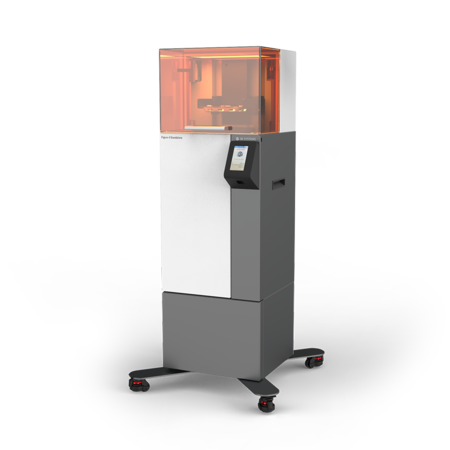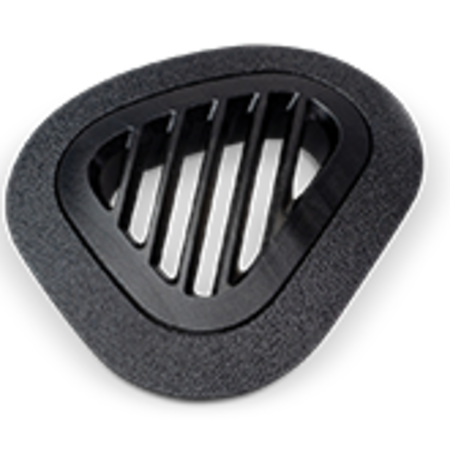Challenge
Speed up and simplify the research and development process with accurate and reliable parts for functional design testing and feedback.
Solution
3D Systems’ Figure 4 Standalone and materials, including Figure 4 PRO-BLK 10, for durable and functional, same-day prototyping.
Results
- Same-day part production and testing;
- Durable parts withstand multiple rounds of in-water test cycles; tests last one to two hours at speeds of 15 to 20 miles per hour;
- Part accuracy provides confidence in test results.
KAI Concepts is a team of creative problem solvers in the Bay Area with unrivaled expertise in building, testing, and controlling hydrofoil systems. Its most recent innovation, the Jetfoiler, is an electric hydrofoil surfboard intended for riders of all ages and abilities. While the mission behind the Jetfoiler is to offer an extremely safe and fun product, the rigorous research and development behind it is thorough and far-reaching. From battery and motor technology to waterproofing, all the R&D done by KAI Concepts is pushing the boundaries of current capabilities and innovation.
According to Kai Calder, who leads logistics and operations at the company, 3D Systems’ Figure 4® Standalone 3D printer and advanced materials have been a big help in advancing the company’s R&D, removing time and unreliable prototypes from its process. In addition to fast print speeds enabling same-day leaps from concept to testing, and durable materials that hold up under rigorous riding conditions. Calder says the accuracy of the Figure 4 prints and overall ease-of-use of the machine have made it a critical and reliable part of the R&D lab.
Print speed enables same-day parts for faster iteration
Before bringing on the Figure 4 Standalone, KAI Concepts was using a competitive desktop system that required double, if not triple the time to complete builds. The introduction of Figure 4’s projector-based, non-contact membrane build technology has not only accelerated print speeds, but also advanced the precision of KAI Concepts’ prototypes, thereby enhancing the quality and speed of data collection.
The change to Figure 4 has profoundly impacted the company’s productivity and allows KAI Concepts to make substantially more progress in development by accelerating part testing and assessment. Prints that used to take a full day of printing can now be printed in half the time, making it possible to post-process them and take them out for testing in the same afternoon.
“By the end of the day, we’re already working on revision B,” Calder says. “The overall process of designing something and reiterating has been cut down immensely for us.”
Depending on part geometries, KAI Concepts is also getting better throughput. Citing a shim design as an example, the company’s previous printer could only fit five or six parts within a build, whereas the Figure 4 enables approximately ten parts to be printed at once.
Reliable part precision drives reliable test data
Beyond speed, Calder notes that part precision has been greatly improved, which is critical to the company’s application. With the products KAI Concepts is testing, if the prints are off, the results are off. According to Calder, the Figure 4 Standalone delivers accurate parts every time he uses it. “It is so crucial that parts like shims be accurate,” says Calder. “If it’s off any little bit, it throws off the ride and the efficiency causing us to derive inaccurate conclusions.”
Other parts demanding precision include the kort nozzle, which incorporates an airfoil section to help the propeller create more thrust. “The fact that we can successfully print this part really shows off the accuracy of the machine, because it’s incorporating all these fine details and smaller airfoil sections, and is actually contributing to increased performance and reliable data.”
Parts printed on Figure 4 are also used as a communication tool between KAI Concepts and its machinists. Having a precise and accurate reference part prior to launching production helps the company problem solve and refine its designs for improved outcomes. In addition to avoiding delays, the company is also being spared the unwanted expenses that come with tooling changes on its part orders.
Durable materials withstand multiple rounds of testing in true-to-life environment
When it comes to additive manufacturing, a printer is only as productive as its materials are suitable to the application in question. Using its previous 3D printer and resins, KAI Concepts was only able to test parts for about 10 to 15 minutes before the parts failed due to the brittleness of the material. With 3D Systems' Figure 4® PRO-BLK 10 production-grade material, however, KAI Concepts is able to test parts for full in-water riding sessions, which last anywhere from one to two hours. 3D Systems’ Figure 4 PRO-BLK 10 is a high precision, production-grade additive manufacturing material with thermoplastic-like material properties and long-term environmental stability.
“The fact that we’re going out and using these parts in the way that we are is a huge testament for the durability of these pieces,” says Calder. During riding sessions, the Jetfoiler and its Figure 4 test parts are going anywhere from 15 to 20 miles per hour through the water, and the test parts are holding up for multiple rounds of comparison tests.
Parts produced range in function from motor mounts to propeller guards and Kort nozzles, each withstanding various loads from people carving back and forth throughout testing, or vibrations from the motor. Parts likewise range in size and extend beyond the dimensions of the Figure 4 build plate. By leaving holes for inserts or guide holes for plastic threading screws, KAI Concepts is printing components in multiple pieces for assembly and having great success in terms of functionality and durability.
“We have a reduced lead time for getting a part, and we’re also getting longer longevity out of the part to be able to reuse it time and time again,” says Calder. “3D Systems’ material knowledge really helps us in making better pieces.”
A straightforward transition to greater productivity
KAI Concepts says it is experiencing the benefits of Figure 4 without complication or confusion, calling the onboarding of Figure 4 a turnkey experience. With occasional help from 3D Systems’ 3D Sprint® software to quickly fix files before sending them to print, Calder says Figure 4 has been very straightforward to learn and use.
“The transition was very seamless,” he says. “We definitely benefit from the emphasis 3D Systems is putting on materials by being able to show other companies what we have been able to achieve. It’s helping us stay on the cutting edge and keep pushing boundaries.”

